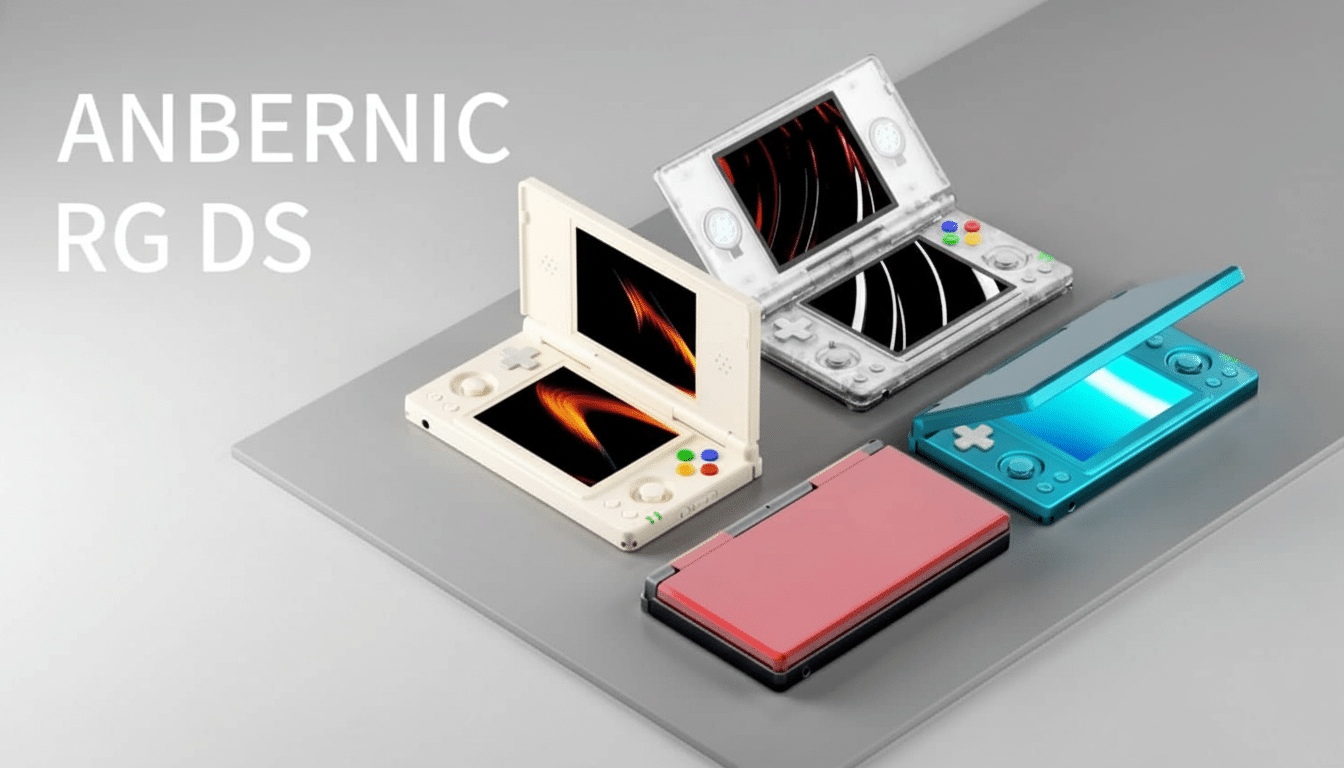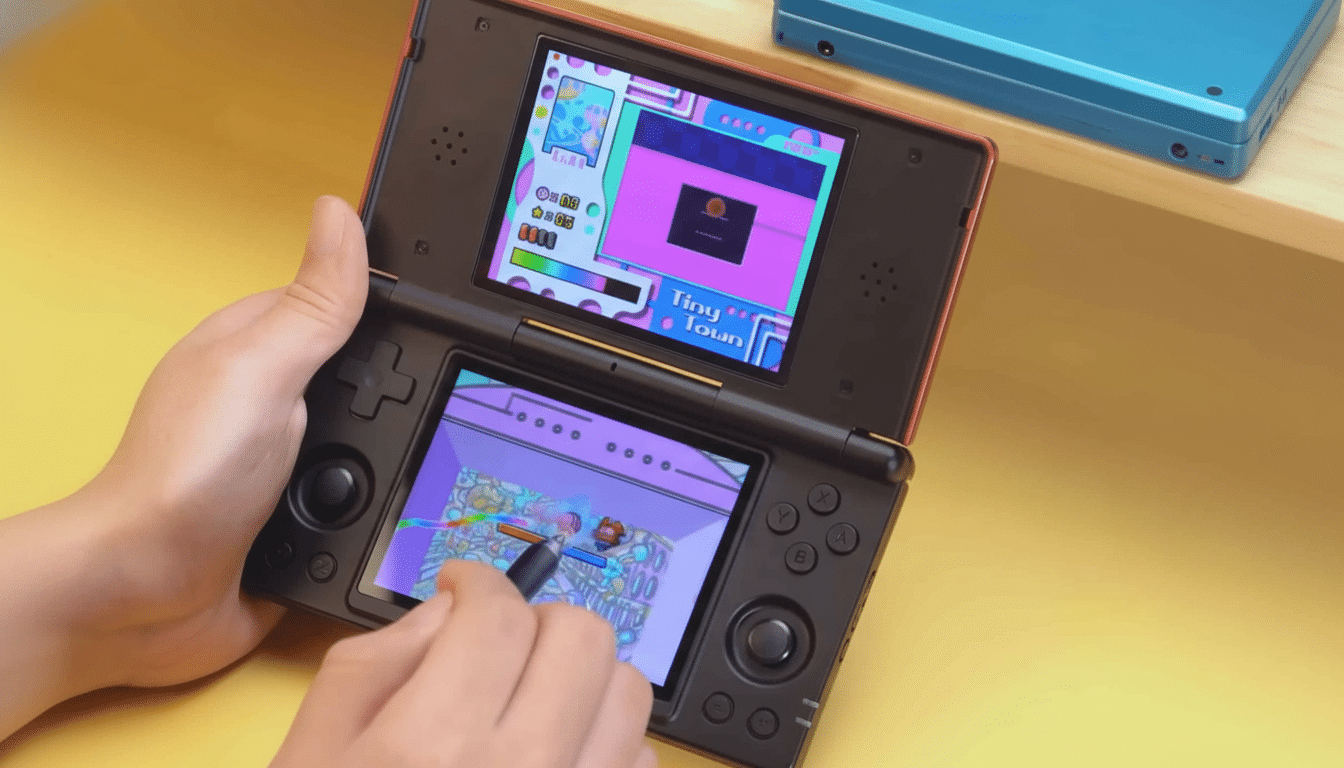There’s a new clamshell handheld that’s poised to undercut the dual‑screen market and add Nintendo DS compatibility (plus a shock sprinkle of 3DS playability) for less than $100. Anbernic’s RG DS, shown off in a new hands-on video posted on YouTube, riffs on the silhouette of the DS Lite but aims for modern emulation based around value rather than raw horsepower.
Dual screens without the premium price tag
Dual‑screen handhelds have been slanting pricey in 2020, with efforts like the AYANEO Pocket DS seeking high-end parts and wonky form factors. Instead, the RG DS embraces simplicity: a small clamshell, common controls, and two separate displays that get rid of the weird screen-mapping shenanigans you have to suffer with on single-screen emulators. The headline is the price — sub‑$100 hardware with two panels and a hinge that still looks burly in early clips.

For context, the DS library includes well over 1,800 titles worldwide and has a heavy leaning toward touch-first game design. It matters, for that library, to have true dual-screen physicality, and it’s a place where add-on screens and portrait phones often stumble. The RG DS more closely mimics the structure in which those games were made to be played by providing a flat, literal top-and-bottom construction.
Early gameplay impressions from hands-on footage
Standout footage in the showcase includes DS titles playing smoothly, and more importantly — two of the less taxing 3DS titles — Rune Factory 4 and Shovel Knight running at playable speed.
Some minor audio tearing was visible in Rune Factory 4, but frame rates remained steady, indicating that the Tegra X1 can handle certain 3DS workloads at or close to native resolution.
Still, expectations should be realistic. High-demand 3DS games — say, Pokémon X and Y, Monster Hunter 4 Ultimate, or resource-intensive first-party showpieces — usually wreak havoc on low-power chipsets. On entry-level handhelds, emulators such as Citra run with lower internal resolution; frameskip and a lightweight build are needed to make it work, even on low-end PCs. RG DS seems like it’s ripe for a “lightweight 3DS” play, rather than the full catalogue.
What to look out for at launch:
- Support for multiple emulator cores in the firmware from day one
- Mature GPU drivers that indicate long-term stability
- Consistent performance across sustained play sessions
Thermal throttling can also make mid-tier handhelds feel powerful in short demos, only to take up the rear over long stretches.
Stylus support and touch latency on the RG DS
Stylistically, the RG DS will embrace touch-based DS gaming with levels of stylus-tapping, and the demo uses precision-heavy games like Trauma Center: Under the Knife. There is noticeable latency in the inputs versus the original hardware, as that used a resistive panel optimized for instantaneous tapping. The touch solution on the new unit seemed more serviceable than surgical — it’s fine for rhythm or strategy games, but surgeons and speedrunners could feel the lag.

One practical note — there doesn’t seem to be an onboard silo for the stylus in this design, though. It’s a minor ergonomic miss on that clamshell shape, particularly when you’re hopping between touch-heavy games. One of those slide-in cases or a magnet-compatible stylus might be an easy fix if one is available.
How it compares with other budget handheld competitors
The RG DS isn’t the first low-cost effort to emulate the DS. Take, for example, the MagicX Zero 40, which relies on a large single screen in an arrangement not unlike 2DS portrait mode, something that, while being cheaper, leads to uncomfortable use for touch applications and a lack of true dual-screen separation. Early testing by the retro handheld community has shown melonDS to be sluggish on that hardware, so users were pushed toward other emulators with features like RetroAchievements support rather than something that melonDS can enable.
Then there’s the Retroid Dual Screen Add-on, which attaches a second screen to any handheld with video output. It’s a smart value buy, but it’s more of a workaround solution — cables, compatibility idiosyncrasies, and added pocket bulk make it one for tinkerers. The RG DS, on the other hand, is positioned as a turnkey clamshell you can power up and play.
Key specs are still under wraps from Anbernic
Chipset, RAM, storage, and battery size are still kept under the lid by Anbernic. Recent sub-$100 retro handhelds from various manufacturers have been riding efficient ARM-based SoCs with low-end GPU drivers that are good enough for native-resolution DS emulation and a few select 3DS titles. Screen resolution will be important: a low-res lower screen like 256×192 is friendly for keeping scaling sharp and avoiding the fuzziness that can affect higher-DPI panels.
Still, other questions we have to look forward to answers about include Wi‑Fi support for firmware updates and achievements, microSD expandability, and whether the unit will come preloaded with community-approved emulators ready to use. Judging by Anbernic’s rhythm in the past, we usually find out everything within a few weeks of pre-order, and from there things start moving fast both at the vendor level and for devs.
Why this matters to retro handheld and DS fans
The DS and 3DS ages were one of the last great strongholds of dual-screen, stylus-first design. Maintaining such experiences without awkward compromises typically entails expensive hardware — or original consoles with aging batteries and frail hinges. If and when that $100 RG DS drops with proper, good-feeling DS play and the 3DS’s lesser games, but it makes do, well, then maybe you’ve got your default starter of choice.
As always, legality is of utmost importance: users should own their own game dumps and be in compliance with any laws in their local region. Organizations like the Video Game History Foundation have observed how modern availability gaps can nudge preservation toward emulation. Cheap, purpose-built hardware could provide a way into that preservation without needing the toolkit of a tinkerer.
Bottom line: the RG DS scales down that dual‑screen dream to something possible. If the specs and firmware on the final hardware match what we’re seeing in this early footage, the sub‑$100 clamshell could pack an above-degree-of-difficulty punch for its price, particularly if you still have interest in the extensive DS library or a selectively chosen crop of 3DS favorites.

